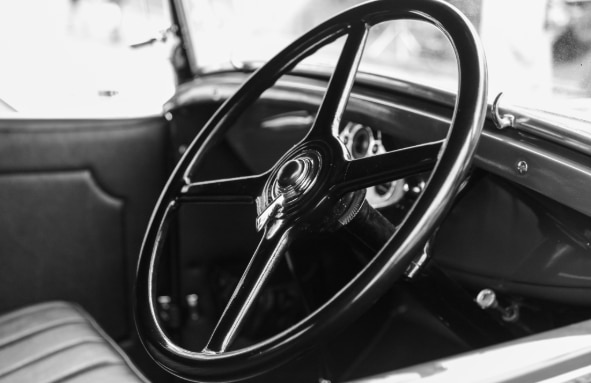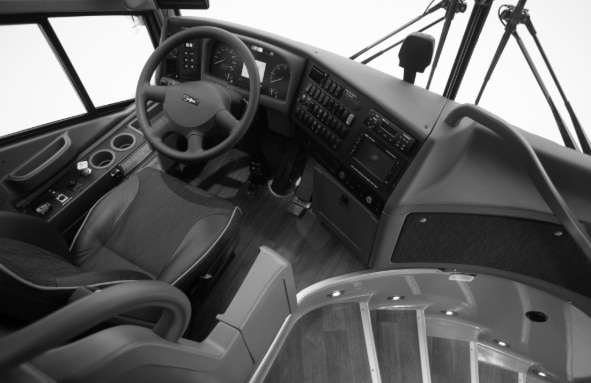Popular Charter Bus Manufacturers: Van Hool
Van Hool is a family-owned commercial vehicle, public transit, and motorcoach manufacturer based in Koningshooikt, Belgium. In Europe, the company is known mostly as a body frame distributor, and recent years have brought more turn-key motorcoach sales to the U.S. market. Annually it produces more commercial trucks (semi-trailers, tankers, etc.) than anything else, but the company prides itself on its line of world-renowned tour coaches and charter buses—with 80% of its vehicles exported across Europe, North America, and parts of Africa and East Asia every year.
As for the vehicles themselves, Van Hool buses have a reputation for combining comfortable interiors with high-end finishing touches that give each ride curb appeal. From roomy cabins with plenty of legroom for everyone to extra-tall front windows for better visibility for drivers and passengers alike, these vehicles know how to make a good first impression.

Images courtesy of Van Hool
HISTORY OF VAN HOOL
Something that might surprise you? The coach manufacturer we know today actually began as a construction company, rebuilding bridges and roads.
Founder Bernard Van Hool needed a large vehicle to haul workers to and from construction sites, but considering that most operational buses and vans had been converted into military vehicles during World War II, he had trouble purchasing one. Luckily, Van Hool was a former mechanic! He found an old, run-down bus, rebuilt the body and frame from scratch, and was so pleased with his work that the rest is history.
Since then, Van Hool has reached a number of milestones over the years. Here are just a few of the highlights:

-
1948
The first line of Van Hool vehicles earns its first public showcase at the Brussels Motor Show
-
1949
First coach is sold abroad (to a private buyer in Luxembourg), beginning the company’s push into the broader European market
-
1951
The company receives its first public contract, providing 10 buses for local Belgian transit
-
1957
Van Hool reaches its first commercial agreement to incorporate Fiat engines and components into European coaches
-
1965
The production line begins introducing more industrial vehicles (tankers and semi-trailers).
-
1966
The first U.S.-bound coaches are manufactured, now utilizing GM components
-
1971
The company establishes its first in-house welding school, which still provides skill training to Belgian workers today
-
1979
After recovering from the oil crisis, Van Hool premieres the Acron, the company’s highest-selling coach of all time
-
1985
Van Hool factories introduce computer-aided manufacturing, leading to the development of lighter, low-floor buses with high passenger volumes
-
1987
The company reaches an exclusive USA distribution agreement with ABC Bus Companies, Inc, marking the beginning of Van Hool’s major expansion to the North American market
-
1995
Van Hool designs a number of vehicles that run on alternative fuels, such as a hybrid midibus and a bi-mode trolley bus
-
2005
The company premiers its first zero-emission, hydrogen-powered bus as it’s incorporated into Dallas public transit
-
2018
Construction begins on a factory based in Tennessee, which is to focus on producing more tour buses for the North American market
Van Hool Today

In recent years, Van Hool has shown growing dedication to reducing the transportation industry’s environmental impact by producing electric buses for both the public and private sectors. A prime example of this is Exqui.City, Van Hool’s line of "tram-buses” for public transit use. These coaches feature a multi-propulsion platform, which can use a variety of environmentally friendly power supplies like hybrid systems or even fuel cells and batteries. The city of Hamburg, Germany.
In light of the COVID-19 outbreak, the company created a campaign to provide Van Hool owners with easy-to-install safety measures that would “future-proof” their vehicles. These include:
- a clear plastic divider between the driver and passengers
- dividers between rows of seats
- optimized HVAC hardware
- a variety of air purifiers and additional AC filters
- removable and washable seat covers
- hand sanitizer dispensers that install into the bus’s door frame.
The Van Hool Fleet
Van Hool offers 11 types of charter bus models, each tailored to the regulations and needs of the continent it serves. For example, the company’s European line features a range of midibuses, a popular touring model that’s bigger than a minibus and smaller than a full-size charter bus. U.S. tour companies often travel longer distances and opt for larger-capacity coaches, so for the North American market, Van Hool supplies a variety of 48- to 56-passenger buses with ample storage space for passengers’ luggage on multi-day trips.
Here in North America, we have these options for private coach buses:

Van Hool’s oldest model:De Trekvogel
Van Hool produced its first vehicle in 1946 by completely rebuilding the body of a defunct old bus. This first coach was dubbed “De Trekvogel,” or “Bird of Passage.” It featured details inspired by contemporary American road cruisers—tailfins, chrome details, and sleek, rounded lines. This style would become a trademark across Van Hool’s early models, catching the eye of buyers at nearly every trade show. Not only did De Trekvogel’s design inspire the company’s meticulous eye for detail, its production introduced touring coaches—and in turn group tourism—back into the European market as the continent began rebuilding after WWII.

Van Hool’s MOST POPULAR model:TX Acron
First produced in the late 1970s, the Acron was a smash hit from the start; Van Hool sold nearly 2,000 within the first 20 years of development—and that number has only skyrocketed since then.
So why is it so popular? It’s one of the most versatile body styles Van Hool offers, with customizable interiors—from plush leather seats with tray tables to sleeper coaches with bunk beds—four sizes to choose from, and the ability to carry diesel, electric, and hybrid engines. When you combine the custom-build features and its reliability on the road, it’s no wonder that the Acron is still one of the most popular coaches available in the European market.
TX Acron standard specs:
- Weight: 50,700-54,000 lbs
- Height: 12 ft., 3 in.
- Width: 8.4 ft.
- Length: 40-45 ft.
- Seats: 48-56
- Luggage compartment volume: 384-440 cu. ft.
- Parcel rack compartment volume: 58-109 cu. ft.

Van Hool’s NEWEST model:CX45E
Unveiled to the public at BUSWORLD EUROPE 2019, this model is the company’s newest fully electric coach intended for the U.S. market. It’s powered by a Proterra E2 battery that has a capacity of 648kwh—for reference, typical extended-range electric bus batteries have a maximum capacity of 300kwh. It can travel 300 km (about 186 miles) before it needs to return to the lot and recharge. Given its energy efficiency and the integration of Van Hool’s newest routing tech, this new model is a great option for employee commuter shuttles in urban areas.
CX45E specs:
- Weight: 50,700-54,000 lbs
- Height: 12 ft., 3 in.
- Width: 8.4 ft.
- Length: 40-45 ft.
- Seats: 48-56
- Luggage compartment volume: 384-440 cu. ft.
- Parcel rack compartment volume: 58-109 cu. ft.

For more information about bus model specifications, refer to Van Hool or ABC Companies (Van Hool’s North American distributor).
Other Popular Bus Manufacturers:
-
Prevost

Prevost's reputation for luxury earned them the opportunity to build the frames for Ground Force One, the fleet of motorcoaches used by the President of the United States.
Learn More About Prevost -
Temsa

With more than 50 years of experience, TEMSA has built a strong reputation as a producer of high-quality commuter and tour buses in 66 countries around the world.
Learn More About Temsa -
MCI

After nearly 90 years in the business, MCI has become one of the largest and most-trusted bus providers in America—which explains why they sell more coaches than anyone.
Learn More About MCI
Learn More About Popular Charter Bus Manufacturers
We are proud to use Van Hool motorcoaches in the National Charter Bus network. Want to learn more about the buses that could be included in your fleet? Check out our other pages on bus manufacturers for more deep-dives, or look through our bus rental options for a general overview of each model.